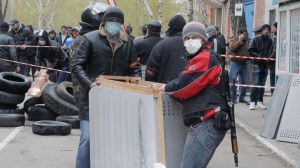UNITED NATIONS — The fate of Ukraine, one of Eastern Europe’s largest countries, hangs in the balance.
On the one hand, ”spontaneous” political demonstrations and government building seizures by pro-Russian separatists, are bringing an air of deliberately planned disorder to the country’s eastern regions bordering Russia.
On the other, rhetorical posturing by the United States and European Union, while clearly warranted, creates a sense of an impending clash with Moscow.

We all know the timeline. Late last year when Ukraine’s government turned down a lucrative trade pact with the European Union in favor of closer ties with Moscow, clashes erupted in the capital Kiev. The political opinions then and now reflect Ukraine’s cultural “fault lines,” namely the eastern regions tend to favor Russia while the larger western regions look towards Europe.
After the corrupt pro-Moscow President Viktor Yanukovych was toppled in February and fled to Russia, an interim government was established in Kiev. Moscow was not amused.
Ukraine’s orchestrated disorder stems from the political choreography of Russian President Vladimir Putin who is using this controlled crisis to facilitate a step-by-step destabilization and possible dismemberment of a sovereign country.
In the afterglow of the successful Sochi Winter Olympics, the Kremlin went for an encore, and annexed Crimea, a majority Russian ethnic peninsula. While Washington and European capitals offered sympathy and echoed support for Ukraine’s sovereignty, not much was done, beyond slapping Putin’s wrist with some sanctions.
Russia’s annexation of strategic Crimea was viewed as a fait accompli, a done deal.
After a brief pause, Putin then presented Act 2, the encouragement and possible coordination of pro-Russian armed separatists to create chaos in the Donetsk region.
The supporting cast here includes over 40,000 Russian troops who are coincidentally and conveniently just across the border from this Ukrainian region.
Clearly while this industrial area is steeped in Russian sympathies, it does not mean it wishes to formally join the Motherland.
U.S. Secretary of State John Kerry warned that Moscow’s actions represent “an illegal and illegitimate effort to destabilize a sovereign state. This could potentially be a contrived pretext for military intervention, just as we saw in Crimea.”
Knowing the possibilities, NATO has wisely militarily reinforced vulnerable members bordering Russia in the Baltic states.
Still the pro-Russian separatists are steeped in the old Soviet-style “agitation-propaganda” tactics where the mob creates local control and authority, and then cries wolf as being the victims when the central Kiev government reasserts its legal authority.
Calls for local referenda and all sorts of autonomy for these restive eastern regions, while seemingly logical, deliberately ignores the fact that such moves must be approved by the whole of Ukraine, not just disgruntled partisans.
The tactic reached new levels of diplomatic theater when Moscow’s UN delegate Vitaly Churkin called for a rare Sunday night emergency Security Council session to dramatize Russia’s concerns over bring the victim of Ukraine!
Russia’s wider narrative is repeated again and again by the chorus, namely that the Kiev government is a “neo- fascist clique” who was not democratically elected. Echoes of the Cold War abound.
Yet a recent UN Human Rights Council report rebuffs much of Moscow’s myth; while there were some attacks against the ethnic Russian community, “these were neither systematic nor widespread.”
What we are witnessing is the stage-managed political drama where the aggressor claims to be the victim, and then conveniently may call upon the nearby Russian army for “fraternal assistance.” Provocations by either side could trigger a pretext for action.
Complicating the situation are Ukraine’s presidential elections slated for May 25th. Moscow is likely pushing for more destabilization, which in turn will make Ukraine’s economic crisis even deeper. Russia would very likely rather see an independent Ukraine implode, being all the more vulnerable to Moscow’s bullying.
Still the real risk remains that Ukraine’s historically Russian and Orthodox-oriented eastern regions could be coerced into an semi-autonomous state which would mirror the old Soviet era Ukraine which claimed an independent legal personality and sovereignty, had UN membership, but was politically, a obedient Soviet socialist republic.
Ukraine’s near-term future may rest on the outcome of a diplomatic deal struck in Geneva among the U.S., EU, Ukraine and Russia to de-escalate the crisis. So will Putin now pause politically, or make his move?
John J. Metzler is a U.N. correspondent covering diplomatic and defense issues. He writes weekly for WorldTribune.com. He is the author of Transatlantic Divide ; USA/Euroland Rift (University Press, 2010).


You must be logged in to post a comment Login